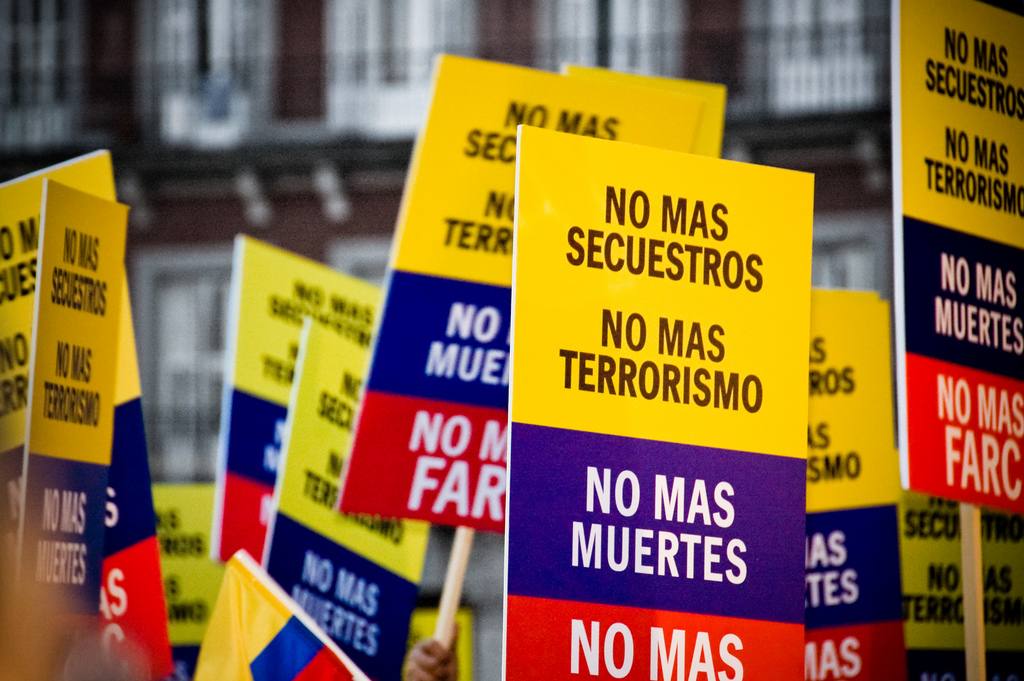On the 23rd of June the Colombian government finally concluded a peace agreement with the FARC (Revolutionary Armed Forces of Colombia). Commentators quickly labelled it a historic moment, which potentially ends the world’s longest insurgency. Signing a peace agreement is, however, one thing, effectively demobilizing fighters and reintegrating FARC-controlled territory another. How should Colombia, and the international community, tackle these problems? How can we end a conflict that left more than 220,000 dead?
Ending the world’s longest insurgency is by no means a small feat. The roots of the FARC can be traced back to La Violencia (1948-1957). Out of these ideological riots the communist-inspired FARC emerged in the mid-1960s. Since their inception, they have allegedly defended the rights of peasants in rural Colombia. Thanks to the coca(ine) trade, the FARC became an economic powerhouse, with a fighting force of an estimated 20,000 combatants in the 1990s. Back then, they failed to conclude a peace deal with then-President Andrés Pastrana (1998-2002). His successor Álvaro Uribe preferred a more repressive strategy, embodied by the US-sponsored Plan Colombia, a financial aid package to combat drugs. Plan Colombia undoubtedly came with great costs, but it weakened the FARC. The guerrillas were eventually forced into negotiations in November 2012. It took four years to agree on a long-awaited cease-fire.
Last month, on the 23rd of June, numerous Latin-American state-leaders and UN Secretary General Ban Ki-Moon attended the formal ceremony to celebrate the peace agreement (unofficial English translation). The UN seized this opportunity to improve its questionable track record in intrastate conflicts. Not only does the guest list reveal the willingness to address civil wars comprehensively; this eagerness also corresponds with reality since civil wars have become the predominant type of war. Civil wars have been historically neglected, but for humanitarian reasons we should welcome any international coordinated effort to bring peace.
The stakes for the accord are very high and failure will be difficult to swallow for all parties involved. Also the legacy of Juan Manuel Santos’ presidency will depend on the unravelling of the agreement. Several external factors are said to hinder the implementation: The plan has an estimated 40 billion dollars cost, Colombians mistrust the FARC, Santos’ popularity has sunk to an all-time low, and the recalcitrant, but popular Uribe opposes the agreement. The final accord will also be subject to a referendum, which should democratize the deal and provide Santos with the much-needed legitimacy. The recent Brexit shows that referenda can go either way, but the agreement itself is worth highlighting. Two provisions in particular have make-or-break potential.
First, the accord stipulates that FARC fighters who have not committed crimes against international law (i.e. human rights and/or international humanitarian law) will be reintegrated into society. In reality, this amounts to amnesty. Uribe has criticized this provision in the past for its impunity, a feeling shared by many Colombians. It is, however, a crucial measure towards durable peace. As opposed to international wars, insurgents do not enjoy immunity from domestic prosecution. This void characterizes the legal bias towards interstate conflicts, although comparatively less prevalent. If not for amnesty, many civil wars would endure, as insurgents have no incentive to end their armed struggle. Amnesty is in line with existing treaty law and has been granted in other peace agreements by the governments of Liberia, Sierra Leone, and Indonesia.
The second provision concerns institutions. The agreement spells out that civilian political bodies should continue their activities in the normalization zones. The Colombian government has never been able to effectively penetrate its hinterland. As a result, citizens have set up city councils to regulate local political life. Throughout its existence the FARC exercised control over these marginalized areas and governed in a relatively cooperative fashion. In many instances it did not replace the city councils, but coordinated their workings. As for now it is unclear whether these mixed-control institutions are in fact ‘civilian’. For the Colombian government it is nevertheless vital to designate them as such. Building political institutions from scratch is a capital-intensive and unpredictable process. Co-opting these existing structures will not only reduce costs, but also locals favour this solution. This provision ideally avoids a repeat of Colombian history. In 2006, the disbandment of the paramilitary organization (AUC) left an institutional void, which the Colombian government left unaddressed. This negligence to respond precisely enabled the rise of criminal gangs (BACRIM).
The adequacy of the implementation of these two provisions will decide the fate of the Colombian peace process. Failure will drive FARC fighters and civilians further into the arms of the smaller ELN, another Marxist insurgency. Although the ELN has been conducting peace negotiations since March, they are not really committed to it. The ELN will eagerly fill in the vacuum left by the disintegration of the FARC. In fact, there are already reports that FARC factions refuse to demobilize and continue fighting. These dissidents cast a shadow over the peace deal, as it indicates FARC leadership to have lost control over its troops. It will also fuel popular opposition to the peace deal, negatively influencing the upcoming referendum.
In spite of Uribe’s criticism, the accord is a good deal and a milestone in the Colombian conflict. Yes, the FARC appears to be committed, but the past teaches us that agreements need to be implemented. The Ugandan LRA and the Sri Lankan LTTE signed cease-fire agreements, which were not honoured. The lack of effective control could render this peace deal unworkable. To ensure durable disarmament, FARC fighters need to be incentivized through amnesty. If not, they will put their fate in the hands of the ELN and continue fighting. Moreover, the Colombian government needs to regain effective control over FARC-held territory through co-optation of existing political structures. The peace agreement is a first step towards peace in Colombia, but it is only a first step. Ending the world’s longest insurgency requires an orchestrated effort.














Leave a Comment
Your email address will not be published. Required fields are marked with *